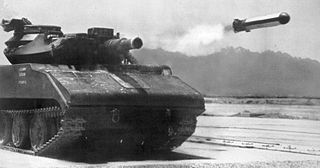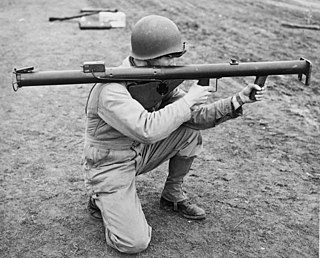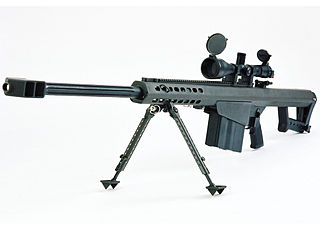
The M1 Abrams is a third-generation American main battle tank designed by Chrysler Defense and named for General Creighton Abrams. Conceived for modern armored ground warfare and now one of the heaviest tanks in service at nearly 68 short tons, it introduced several modern technologies to United States armored forces, including a multifuel turbine engine, sophisticated Chobham composite armor, a computer fire control system, separate ammunition storage in a blowout compartment, and NBC protection for crew safety. Initial models of the M1 were armed with a 105 mm M68 gun, while later variants feature a license-produced Rheinmetall 120 mm L/44 designated M256.

The Ford MGM-51Shillelagh was an American anti-tank guided missile designed to be launched from a conventional gun (cannon). It was originally intended to be the medium-range portion of a short, medium, and long-range system for armored fighting vehicles in the 1960s and '70s to defeat future armor without an excessively large gun. Developing a system that could fire both shells and missiles reliably proved complex and largely unworkable for the United States.

A bazooka is a man-portable recoilless anti-tank rocket launcher weapon, widely deployed by the United States Army, especially during World War II. Also referred to as the "stovepipe", the innovative bazooka was among the first generation of rocket-propelled anti-tank weapons used in infantry combat. Featuring a solid-propellant rocket for propulsion, it allowed for high-explosive anti-tank (HEAT) shaped charge warheads to be delivered against armored vehicles, machine gun nests, and fortified bunkers at ranges beyond that of a standard thrown grenade or mine. The universally applied nickname arose from the M1 variant's vague resemblance to the musical instrument called a bazooka invented and popularized by 1930s American comedian Bob Burns.

The MBT-70 was an American–West German joint project to develop a new main battle tank during the 1960s.

An anti-materiel rifle (AMR) is a rifle designed for use against military equipment, structures, and other hardware (materiel) targets. Anti-materiel rifles are chambered in significantly larger calibers than conventional rifles and are employed to eliminate equipment such as engines and unarmored or lightly armored targets. While modern armored vehicles are resistant to anti-materiel rifles, the extended range and penetration still has many modern applications. While not intended for use against human targets, the bullet weight and velocity of anti-materiel rifles gives them exceptional long-range capability even when compared with designated sniper rifles. Anti-materiel rifles are made in both bolt-action as well as semi-automatic designs.

The M60 is an American second-generation main battle tank (MBT). It was officially standardized as the Tank, Combat, Full Tracked: 105-mm Gun, M60 in March 1959. Although developed from the M48 Patton, the M60 tank series was never officially christened as a Patton tank. The US Army considered it a "product-improved descendant" of the Patton tank's design. The design similarities are evident comparing the original version of the M60 and the M48A2. It has been sometimes informally grouped as a member of the Patton tank family. The United States fully committed to the MBT doctrine in 1963, when the Marine Corps retired the last (M103) heavy tank battalion. The M60 tank series became America's primary main battle tank during the Cold War, reaching a production total of 15,000 M60s. Hull production ended in 1983, but 5,400 older models were converted to the M60A3 variant ending in 1990.

The C1 Ariete is a 3rd generation main battle tank of the Italian Army, developed by Consorzio Iveco Oto Melara (CIO), a consortium formed by IVECO and OTO Melara. The chassis and engine were produced by Iveco, while the turret and fire-control system were supplied by OTO Melara. The vehicle carries the latest optical and digital-imaging and fire-control systems, enabling it to fight day and night and to fire on the move. Six prototypes were developed by 1988, which were subject to intensive testing. The following year the vehicles travelled a combined 16,000 km. Deliveries were first planned for 1993, and took place in 1994 due to delays. Final delivery occurred 7 years later in August 2002.

The RPG-29 "Vampir" is a Soviet reusable rocket-propelled grenade (RPG) launcher. Adopted by the Soviet Army in 1989, it was the last RPG to be adopted by the Soviet military before the fall of the Soviet Union in 1991.
The General Dynamics Land Systems (GDLS) M60-2000 or 120S was an upgrade of the M60 tank. The development of the M60-2000 was initiated primarily due to the large number of M60 main battle tanks in service with many Middle Eastern nations unable to afford a sufficient force of more modern main battle tanks. The upgrade was marketed at those M60 users with the industrial capability to convert the tanks themselves. The M60-2000/120S was a GDLS supplied conversion kit that married the turret of the M1A1 variant of the M1 Abrams to the M60A1 hull of the M60, offering many features of the M1A1 Abrams to existing M60 users at a reduced cost.

The M7 grenade launcher, formally rifle grenade launcher, M7, was a 22 mm rifle grenade launcher attachment for the M1 Garand rifle that saw widespread use throughout World War II and the Korean War. The M7 was a tube-shaped device, with one end slotting over the muzzle of the rifle and attaching to the bayonet mount, and the other end holding the grenade in place. Blank cartridges were loaded into the rifle prior to firing. When fired, the expanding gases generated by the cartridges propelled the grenade forward with considerable force. The M7 could fire grenades up to 200 metres, compared with the maximum of 30 metres achieved by a hand-thrown grenade.
The M1 Abrams main battle tank has been in service since 1980. Since then, it has gone through dozens of upgrades and been the baseline variant of several vehicles.

The M3 Bradley Cavalry Fighting Vehicle (CFV) is an American tracked armored reconnaissance vehicle manufactured by BAE Systems Platforms & Services. A member of the Bradley Fighting Vehicle family, the M3 CFV is used by heavy armored cavalry units in the United States Army.

Man-portable anti-tank systems are traditionally portable shoulder-launched projectile systems firing heavy shell-type projectiles, typically designed to combat protected targets, such as armoured vehicles, field fortifications and at times even low-flying aircraft.
The post–Cold War era is the period in world history from the collapse of the Soviet Union on December 27, 1991 to the present. During the Cold War, the Soviet domination of the Warsaw Pact led to effective standardization on a few tank designs. In comparison, France, Germany, the United States, and the United Kingdom had previously developed their own tank designs, but now tried to standardize their designs, while the smaller nations of NATO purchased or adapted these designs.

The FV4601 MBT-80 was a British experimental third-generation main battle tank, designed in the late 1970s to replace the Chieftain tank. It was eventually cancelled in favour of the Challenger 1, itself an evolution of the Chieftain design.

The CM-11 Brave Tiger is a main battle tank (MBT) that was developed by the American General Dynamics and the Republic of China Army Armored Vehicle Development Center. It was introduced to the public on 14 April 1990. The CM-11 is a hybrid M60 chassis fitted with the turret from the older M48 Patton and the fire control system of the M1 Abrams.

The M1074 Joint Assault Bridge System is an American armored military engineering vehicle based on the Abrams M1A1 main battle tank chassis. The M1074 was designed by Leonardo DRS for the U.S. Army and Marine Corps to provide deployable bridge capability for units engaged in military operations.

An unidentified model of a North Korean main battle tank was unveiled during the October 2020 military parade that commemorated the 75th anniversary of the foundation of the Worker's Party. It has been given the unofficial name "M2020".















